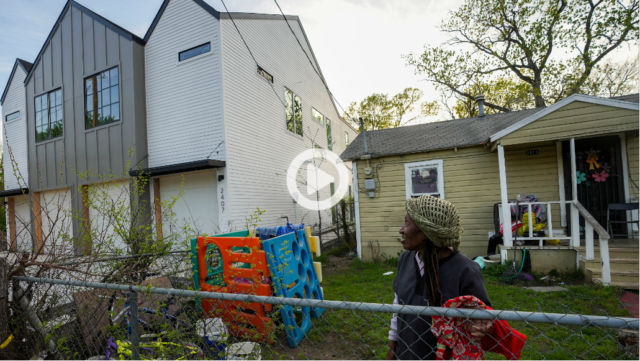By Dianne Solis

Every week, Paula Hutchison and Lottie McKnight-Calhoun reject offers for their modest homes.
Family legacy and Black history aren’t up for grabs, they say.
Their houses sit in one of the hottest real estate plays in North Texas — Gilbert-Emory, once a predominantly Black neighborhood in West Dallas, south of Singleton Boulevard, not far from the Margaret Hunt Hill Bridge.
Here, squat shotgun houses flecked with turquoise trim sit next to towering townhomes in trendy grays and whites. Sidewalks for new houses — and no sidewalks for older ones — mark the changing neighborhood of 250 residents whose origins date back at least a century.
Now, gentrification races through the streets so fast that a shotgun can be shaded by a townhome in a matter of months.
A decade ago, some houses with barely 700 square feet of space were valued at a mere $11,000 by county appraisers. The new townhomes three times their size ascend next to them and sell for $600,000 or more.
“I grew up in an area where generational wealth became important to me. A home is stabilizing,” said Hutchison, a retired Navy veteran and community organizer in her 60s.
She leads an effort to bring recognition to the working-class Black families who four generations ago settled in a neighborhood now named after two Black grocers who kept people fed in a time of rampant segregation. Hutchison grew up in the neighborhood, and her sister still lives in the family home.
McKnight-Calhoun and Hutchison, along with other Gilbert-Emory residents and property owners, are struggling to preserve their neighborhood’s identity and history as the pricey development now on almost every block threatens their legacy. The new homes have led to skyrocketing property taxes many say they can no longer afford.
This trend has been repeated throughout Dallas and across the nation many times over, so often so that longtime residents hope their story won’t be ignored. There’s not been a national survey or real estate journal in recent years that hasn’t spotlighted Dallas and North Texas as one of the hottest housing markets in the country.
This is why Gilbert-Emory’s story is worthy of attention.
/cloudfront-us-east-1.images.arcpublishing.com/dmn/UQWSSAD3EFDWNGADOH5WPJXI4M.jpg)
Whether it’s in Harlem or Brooklyn or neighborhoods in Los Angeles, the loss of culture, Black-owned businesses and homes close to a city’s center hits hard, Dallas historian Donald Payton said.
Losing property in Black neighborhoods close to downtowns also impedes the growth of generational wealth. Federal Reserve research for 2019 shows a typical white family has eight times the wealth of the typical Black family, and five times that of Latino families.
Black homeownership is also much lower than white homeownership, according to the U.S. Census Bureau.
While Dallas still has some historically Black neighborhoods, including Hamilton Park and Elm Thicket in northern Dallas, many such as what once was the State-Thomas neighborhood — what’s now called Uptown — have disappeared.
“Gilbert-Emory is extremely important to us,” said Dallas City Council member Omar Narvaez, who has represented West Dallas since 2017. “It’s important that we continue to uphold this neighborhood and remember its historical significance. And I’m doing everything in my power to do that.”
Narvaez pointed to tax breaks for those undergoing home repairs as an example. He noted that some zoning changes occurred before he was elected. And those policies have resulted in the luxury apartments and townhomes that now tower over older homes, he said.
“There’s a way to gentrify without it feeling like a hostile takeover,” said Raul Reyes, president of West Dallas 1 neighborhood coalition, which includes Gilbert-Emory. “It’s not about how many homes can be built, but how many can we preserve.”
Buzzwords for ‘removal’
Gilbert-Emory residents hope to establish a historical marker later this year honoring the school in their community. The school’s roots go back to the early 1900s. Torn down in the early 1980s, the school was named after the abolitionist Frederick Douglass — as a nod to his belief that Black people could secure generational wealth through homeownership.
“Over the years, we have been victims of urban renewal and urban revitalization. Those are buzzwords for ‘removal,’ ” Payton said. “Look at it on a national level. If they can take New York, everything else is fair game.”
Neighborhoods like Gilbert-Emory were safe havens for many Black residents, said Payton, 75. He has chronicled Black Dallas history for several decades.
While clearly pride over homeownership was important to GIlbert-Emory residents, entrepreneurship was, too. The neighborhood bustled decades ago with Black-owned businesses, including those run by the grocers Nathan and Margaret Gilbert and Cecil and Helen C. Emory. There were cobblers and laundry entrepreneurs who ran home businesses, hairdressers and a gregarious one-armed barber.
“At one time, everybody who lived over here knew everybody else,” Payton said. “Everybody was either kinfolk, best friends or lifelong friends. And now we see that we are in the shadow of downtown Dallas. So in just another few years, it’s going to be dog parks and bike paths.
“And if we don’t work to preserve our stories, they are going to be forgotten.”
Andrea Roberts, a University of Virginia historian, said Black neighborhoods across the nation are more vulnerable for erasure because they are often located near downtowns and experience rising property taxes.
Her Texas Freedom Colonies Project has documented more than 500 Black communities established in Texas between 1866 and 1930. Her work identifies 15 historically Black communities in Dallas County, and new ones are being added. Gilbert-Emory is not yet on the list.
Cities need to ask themselves whether they want to stabilize existing neighborhoods or encourage a “Disneyfication” of neighborhoods that makes them “a fun place for those between 25 and 40″ years old, Roberts said.
“We need to recognize and confront and enable communities to seek redress, not just historical markers,” she said.
Changing demographics
Gilbert-Emory spans about a dozen blocks, largely sandwiched between railroad tracks and what once were bustling cement and steel factories, including Atlas Metal Works with its gable-roofed buildings on the corner of Singleton Boulevard and Sylvan Avenue.
Thirty years ago, about half of Gilbert-Emory’s nearly 400 residents were Black, according to Census data. By 2020, the neighborhood’s population had fallen to 250, only a fifth of which was Black.
Even as Gilbert-Emory’s population has declined, the larger section of West Dallas just across the Margaret Hunt Hill Bridge — a census tract surrounding Gilbert-Emory — has seen an influx of newcomers in the last 10 years. The edge of the community is a mere two miles from downtown Dallas.
From 2010 to 2020, the total population in this section of West Dallas grew by 130% to almost 5,500 people. The number of white residents grew more than 1,150%, from only 121 to 1,517. The number of Black residents grew 390% to 1,205. And the number of Latinos increased 16% to 2,291.
The redevelopment that has drawn these newcomers has led to soaring housing prices in the rest of West Dallas, too.
The median market value of houses in Gilbert-Emory grew more than 10-fold, from $14,105 to $153,750 from 2017 to 2022. That far outpaced the increase across Dallas, where the median market value doubled, from $115,540 to $235,620.
More recently, from 2021 to 2022, the median market value of houses in Gilbert-Emory nearly tripled, compared to 27% growth across the city.
Many of the neighborhood’s new $600,000 homes, ranging from 1,900 to 2,700 square feet, come with three bedrooms and balcony views of the Dallas skyline.
In the floodplains and redlined
Early Black neighborhoods like Gilbert-Emory were often located in the floodplains of the Trinity River, Payton said. “Black folks,” he said, “couldn’t buy prime real estate or couldn’t buy houses up on hills.”
In the 1930s, the federal Home Owners’ Loan Corp. created color-coded maps of every major city in the U.S. A neighborhood was given a red color if Black residents lived in it, even if it was solidly middle class, according to Richard Rothstein, author of The Color of Law: A Forgotten History of How Our Government Segregated America.
A large swath of West Dallas was redlined and graded risky. The Dallas map noted the “infiltration” of Black residents and foreign-born families of “Italians and Mexicans.”
West Dallas north of the railroad, where Gilbert-Emory lies, “contains the lower grade of population and cheaper, poorly maintained properties,” stated remarks in the Home Owners’ Loan Corp. maps. Among listed “detrimental influences” were a cement plant, a fertilizer factory and many other small industrial plants, plus unpaved streets.
The Frederick Douglass school opened around 1904, according to historical documents, and at its height it had more than 300 children from West Dallas neighborhoods, said three former students who became Dallas ISD teachers.
The school was so important to the community that many old-timers still use the abolitionist’s name when referring to their neighborhood. The school produced its own teachers.
The largest institutions remaining in Gilbert-Emory are four small churches with Black congregations and Black preachers. Three are clustered in the heart of the Gilbert-Emory neighborhood. The biggest is Greater Mount Pilgrim Church, which still has a congregation of about 300 people.
“Churches, beauty shops, barber shops, corner grocery stores — those people were our everything,” said McKnight-Calhoun, a 71-year-old retiree who lives in her deceased parents’ home behind an old metal works business. “That is how we survived. They were our rocks in times of storms.”
The asset of homeownership
The homes served as community anchors, too. Home ownership is often the biggest asset to a family, building wealth that can help lift the next generation. That was true for McKnight-Calhoun and her siblings, who, like many of the remaining Black residents, inherited their parents’ house.
All around the homes of McKnight-Calhoun and Hutchison, there’s the buzz of construction equipment most days, from bulldozers to nail guns.
/cloudfront-us-east-1.images.arcpublishing.com/dmn/7T7GQGCU5VEDTNTJ4D7JMU2RH4.jpg)
On Duluth Street are newly paved sidewalks with landscaping of heat-tolerant cenizo and yucca with red plumes in front of apartments, where monthly rent starts at about $2,200. The new townhomes feature horizontal cedarwood fencing and concrete gutters.
The McKnight-Calhoun home sits behind the defunct Atlas Metal Works. The art deco office and the silver and rust business structure have caught the attention of historic preservationists. But the area was rezoned this year to allow for more high-density residential apartments and retail. Destruction of the metal buildings began in April.
Older homes in the neighborhood have chain link fences and frequently lack sidewalks and paved gutters. Many feature old trees and gardens, speaking to years of care.
Gone are a nearby waste disposal company and a bridge and road construction plant that once lined Singleton Boulevard.
Longtime Latino residents in Gilbert-Emory face the same pressures. Miguel Mendoza, 65, moved into the neighborhood more than 30 years ago. His small brick house without sidewalks may be valued on tax rolls at about $100,000.
However, Mendoza, a construction worker, said he believes it would cost $400,000 to start over in Dallas. His asking price when developers come to chat: Half a million dollars.
“That’s the minimum,” Mendoza said in Spanish, standing at his front gate as the family dog, Cuca, barked at an ice cream truck. Asked how many developers have come, Mendoza only said, “Muchos.”
Greater Mount Pilgrim Church
One Sunday last fall, sunlight streamed through the amber-colored windows of the Greater Mount Pilgrim Church on Bayonne Street.
The organist played gently as the choir sang boldly. “Jesus, he will take care of you. I can call him in the morning. I can call him in the middle of the night. Jesus, he will take care of me.”
Those in their red-cushioned pews rose and sang along. Three pastors took turns at the pulpit. The youngest worked up a sweat as he preached and bounced in his black sneakers.
/cloudfront-us-east-1.images.arcpublishing.com/dmn/UMWWIU6O4JCZRGJGB3DXD7TU7M.jpg)
The Rev. Ned Armstrong took it in with a smile.
This is the largest church in Gilbert-Emory, with two parking lots on either side of its beige brick building with a pitched roof. It sits at the heart of the old neighborhood. But these days, most of the congregants drive in from other parts of the city.
After services, Armstrong, a tall man in a gray suit, greeted congregants in the back kitchen with bowls of corn chips and chili.
Plenty of developers have come to him, trying to buy the four lots of Mount Pilgrim, the pastor said. He’s turned each of them away. He was offered $200,000 per lot by one, for a total of $800,000.
Was that enough?
“Noo-ooooo.”
A man from California offered $2.1 million but never submitted anything in writing, the pastor said.
For the church, leaving Gilbert-Emory and starting fresh in another location would be prohibitively costly, Armstrong said.
/cloudfront-us-east-1.images.arcpublishing.com/dmn/VLRXLDV6TFHJFLMJOIWYA5TLSA.jpg)
The church has been in Gilbert-Emory since the mid-1990s when its predecessor, Mount Gilead Baptist Church, moved further south. Mount Gilead had been on Bayonne Street since 1926 and its congregants came from the neighborhood, McKnight-Calhoun said.
A cornerstone of history
In 2018, Armstrong hosted a meeting with a developer who bought the land that had housed the Frederick Douglass school on Bayonne Street.
As a leader in the neighborhood association, Hutchison was there, too. The nearly 2 acres of property had already sold for $1.7 million in 2017, according to Dallas ISD documents.
Its sale was a sore point among Gilbert–Emory’s old-timers, who saw the school as a cornerstone of their community and its history.
Trustees from two Black churches, including the predecessor to Mount Pilgrim, had tried to buy the land from Dallas ISD but were rebuffed, said McKnight-Calhoun and others. McKnight-Calhoun’s father, Jewell McKnight, had been a church deacon.
Bertric Armstrong, the pastor’s wife, showed a reporter a copy of a 2015 check for $1,000 made out to Dallas ISD — an entry fee to bidding. She said it wasn’t the first time Mount Pilgrim had tried to buy the property.
But when the bidding began for the sale that closed in 2017, the Armstrongs said they saw no notification.
Trevor Brickman, president of Centre Living Homes, calls himself a history buff. When he heard that an old school had been located on the land his firm bought, he agreed to name a street after Frederick Douglass. A historical marker honoring the school and Douglass is next, he said.
“They asked if we could honor the school’s history and do a marker,” Brickman said. “I said sure.”
Brickman said he was particularly impressed with Hutchison and her determination and work exhuming the school’s history.
It’s a small victory, but Hutchison said it’s an important one. The school stood for one thing — excellence, she said.
“If you attended Fred Douglass, you were educated,” she said. “You were expected to maintain standards beyond the norms. The educators took pride in what they did. Discipline problems? They were nonexistent.”
At the site of the former school, 27 new homes with starting prices above $550,000 were sold last year and this year. The homes are painted shades of gray and navy with metal gabled roofs. The development is called Emory Park. Nearby is a mini-park named after Helen C. Emory, the Black grocer.
Gentrification has upsides and downsides, said Butch McGregor, a developer with West Dallas Investments, a group playing a pivotal role in the transformation of West Dallas.
The group is behind the Trinity Groves restaurant cluster at the foot of the Margaret Hunt Hill Bridge and responsible for some of the new apartments along Singleton Boulevard within a mile of Gilbert-Emory.
That development, which opened in 2013, has brought in more restaurants, from juice bars to a Black-owned coffee shop called Soiree, which swells with patrons for its jazz brunch on weekends.
Tax rates have gone up as market values have soared, a hardship for the established working class in the neighborhoods but a plus for the city of Dallas, McGregor said.
And displacement of longtime residents? “That is an unfortunate situation,” said McGregor. “That happens with progress.”
But “their homes are their greatest asset,” he said. “Typically, that is the case. So from that standpoint, I’m delighted to see that the values are increasing so that they do have something, and I’m sure they never anticipated the kind of values that they’re getting for these homes.”
Property owners, though, say if they sell, they would never be able to afford a new home in Gilbert-Emory. Already, many said the higher taxes are a struggle.
Hutchison said she asked Brickman whether his company could fund housing repairs for existing homeowners in the neighborhood. Brickman said he doesn’t remember the request.
Efforts to preserve the neighborhood
Hutchison and other property owners made other attempts to preserve the character of the neighborhood.
They tried to get a neighborhood stabilization overlay, a zoning mechanism that would have restricted new construction to single-family residences at a certain height. Hutchison shared a 2018 email from a city planner explaining why the city couldn’t establish such an overlay.
Such overlays exist in about a dozen locations throughout the city, including La Bajada, a neighborhood across Singleton that’s adjacent to the Trinity Groves restaurant cluster at the foot of the bridge, according to the city of Dallas.
The stabilization overlay in that area was put in place in 2012 when development was expected to come through existing neighborhoods with the opening of the big and pricey Margaret Hunt Hill Bridge that same year.
But the Gilbert-Emory stabilization effort failed. Hutchison learned she was too late.
Solicitations by phone and postcard
A few blocks away, Gloria Johnson, a 77-year-old preacher and former model, tried to relax in her home. This was in December. Silk bouquets of purple flowers decorated the tables. Lilac curtain sheers framed the window. Black angels in porcelain perched on an end table.
At the end of her street and behind her home, dozens of three-story townhomes fetch $634,000 or higher.
/cloudfront-us-east-1.images.arcpublishing.com/dmn/N22LJRSCWNESXIO27LWKKHWGAY.jpg)
Every week, she receives up to 10 phone calls and postcards asking whether she would sell the house on Amos Street. A reporter heard two of the phone calls.
She’s proud to own the home. For one year, her family lived in West Dallas housing projects. Then, her father, a butcher with a third-grade education, bought the property on Amos Street and built their home in a neighborhood with “people who looked like us.”
Before her mother died, she told her daughter in a whisper, “Pay the taxes so they won’t take the house. Baby, pay the taxes so they won’t take the house.”
Last year, a man made a $60,000 offer, she said. The house was on the tax rolls for three times that amount.
She scoffed at the offer. “It isn’t about stopping progress,” Johnson said. “It’s about preserving. We earned this.”
Then, the phone rang. She hit the speaker button.
“I’m looking for Gloria Johnson,” a woman on the other end said.
“Speaking.”
“I’m just calling about your property … if you are interested in selling it?”
Data journalist Jose Luis Adriano conducted the data analysis for this story.
CORRECTION, 1:42 p.m., May 3, 2023: An earlier version of this story incorrectly attributed the value of some Gilbert-Emory houses to city appraisers. County appraisers do that valuation.









